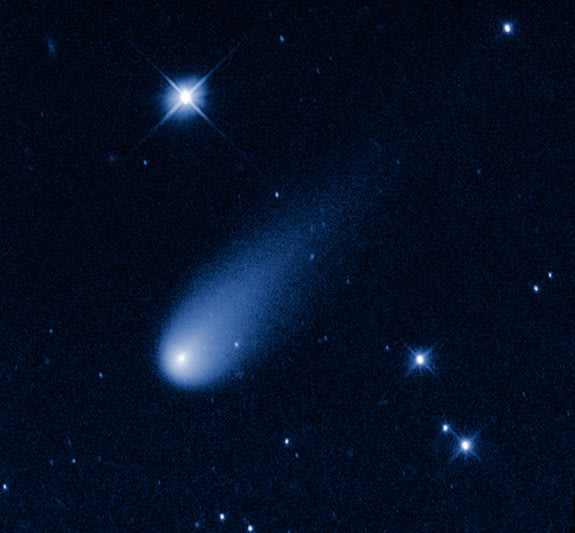The Great Cometby Frank Hoogerbeets
August 20, 2013
In my previous article “Return of the Comet” I explained in detail how my research into Comet ISON came about. Interestingly, on the very same day Dahboo Seven posted a video on Youtube – now included in the article – which will make one wonder what NASA is actually covering up about this comet. I also found another article which was posted just days after ISON's 'discovery' in 2012:
http://www.space.com/17762-newfound-comet-dazzling-2013-display-c2012s1.html. The following quotation from that article is very important:
The most exciting aspect of this new comet concerns its preliminary orbit, which bears a striking resemblance to that of the “Great Comet of 1680.” That comet put on a dazzling show; it was glimpsed in daylight and later, as it moved away from the sun, it threw off a brilliantly long tail that stretched up from the western twilight sky after sunset like a narrow searchlight beam for some 70 degrees of arc. (A person's clenched fist, held at arm’s length, covers roughly 10 degrees of sky.)
The fact that the orbits are so similar seems to suggest Comet ISON and the Great Comet of 1680 could related or perhaps even the same object.
However, they are not the same comet – according to NASA. So now astronomers hypothesize that these comets may be somehow related and possibly share a common progenitor. But what is the foundation for NASA's claim that these are two different comets if their orbits are so similar? Time for a history lesson!
The Great Comet of 1680 was the first comet discovered by telescope. It was spotted on November 14, 1680 by Gottfried Kirch. The passing of this comet was used by Isaac Newton to test Kepler's laws. The concept of periodic comets, i.e. comets actually orbiting the Sun, was not established at the time. In 1695 Edmund Halley suggested for the first time that the comets of 1531, 1607 and 1682 were the same because their trajectories showed great similarities. If he was right then this comet would have an orbital period of approximately 76 years and would return around 1758, which it did. It was only through observation and comparison of multiple passages that the orbital period of this comet, now called Halley's Comet, was accurately calculated. Halley also tried to find out the orbital period of the Great Comet of 1680. He thought it was the same comet that had been seen before and suggested an orbital period of 575 years. NASA claims that modern analyses have refined the numbers and proposes that the semi-major axis of the great Comet of 1680 is 444 AU with an orbital period of almost 10,000 years. However, comparison of the old and new data shows that the trajectories are virtually identical with only slight differences in velocity.
Let us assume for a moment that NASA's claim is incorrect and that the Great Comet of 1680 and ISON are actually the same. Then it must be possible to derive the actual semi-major axis from an orbital period of approximately 333 years with the dates of perihelion for 1680 and 2013 still intact.
In 2006 I discussed some formulae in articles about the Solar System which are very useful for our purpose. In order to keep this article readable for everyone, I refer to a previous article about orbital periods for those who want to work out for themselves how I obtained the semi-major axis for this comet. Using the formula as described in this article, the semi-major axis for an orbital period of 333 years would be 47.98 AU (1 AU = 149.6 million kilometres, the mean distance from the Sun to the Earth).
From the NASA website I obtained the orbital elements of C/1680 V1, the Great Comet of 1680, and entered them into my astronomy program, but with the adjusted semi-major axis. If my theory was correct then I would only have to adjust the semi-major axis slightly to match both dates of perihelion. So after tuning a little, I finally came to a semi-major axis of 48.036 AU, very close to my initial approximation. This was a eureka moment! With the official orbital elements of C/1680 V1 and its semi-major axis adjusted, it turns out that the Great Comet, after its perihelion on December 18, 1680, would have its next perihelion on November 28, 2013, the exact date calculated by NASA! It will probably not be easy to check the validity of my new found semi-major axis with a backyard telescope. The real difference will be the comet's velocity, but even that is difficult to check given the relatively small trajectory that can be observed from Earth.
However, we do have history! So with the adjusted orbital elements, let us see what happened during previous passages and if they corresponded with world events as we know them. From my previous article we may conclude that the 1680 passage did not have wide-spread effects on Earth, like major tsunamis or great plagues. This corresponds well with this passage:

The image is for December 12, 1680, six days before the comet reaches perihelion. Earth is at a safe distance, and does not get in its tail.
From the 1347 passage of Comet Negra, we know that there was the Black Death, a great plague all over Europe which reduced the population by 30 to 60 percent! Could this comet have been the cause for one of the greatest plagues in human history? Let us see:

As it appears Comet Negra came very close to Earth. The comet was still on its way to perihelion which its reached around January 2, 1348, depending on perturbations of its orbit. Earth certainly went through at least a part of the comet's tail, which corresponds well with what people at the time experienced:
read on:  http://www.ditrianum.org/English/Articles/History/0029.htm
http://www.ditrianum.org/English/Articles/History/0029.htmLove Always
mudra













